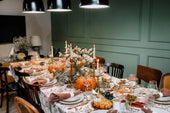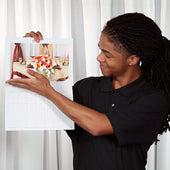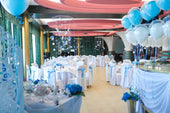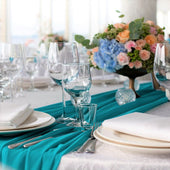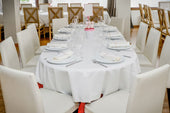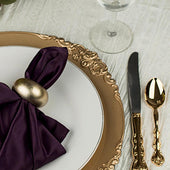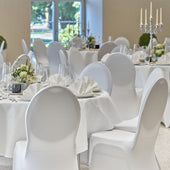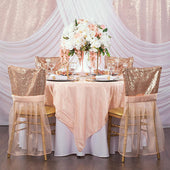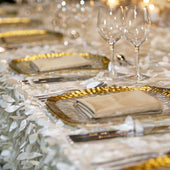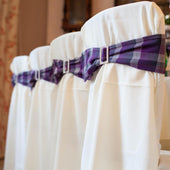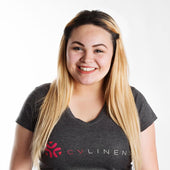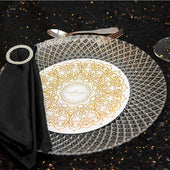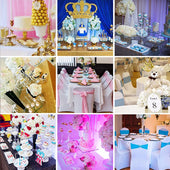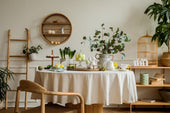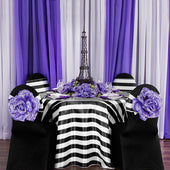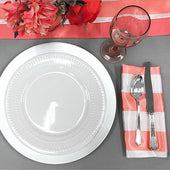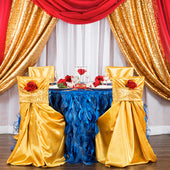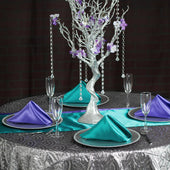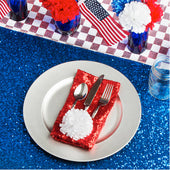Summary / TLDR
Backdrop draping is the art of styling fabric panels on a backdrop frame to enhance an event space. It can be done by layering sheer or opaque fabrics over crossbars and uprights, typically using a pipe and drape set as your base. Common styles include symmetrical pleats, center pulls, criss-cross designs, and swags. You’ll need backdrop stands, panels, ties or clips, and optionally, lighting. Draping is ideal for weddings, birthdays, corporate events, and photo ops.
Backdrop draping can instantly transform any plain wall or empty space into a captivating focal point. Whether you’re styling a wedding altar, a sweetheart table, or a corporate step-and-repeat, the right fabric draping adds texture, color, and elegance to your setup.
This guide will walk you through the essentials of how to do backdrop draping, including supplies, step-by-step instructions, design tips, and popular styles by occasion.
For larger gatherings or repeat celebrations, our bulk tablecloths make it easy to keep every table uniformly styled while letting your decorative accents shine.
What You Need to Start Draping
Before you begin, gather the following materials:
- Backdrop Stand Kit: Start with a reliable base set like uprights, crossbars, and bases to form your frame.
- Draping Fabric Panels: Voile, polyester, satin, or sequin, depending on your event.
- Backdrop Clips or Zip Ties: To secure fabric in place.
- Decorative Elements: Such as fairy lights, florals, or garlands for added flair.
- Weights or Sandbags: Especially if the setup is outdoors.
- Optional Draping Props: Try using arch backdrop props for unique curved styles.
Step-by-Step: How to Drape a Backdrop
1. Assemble Your Backdrop Frame
Set up your uprights and crossbar on weighted base plates to ensure stability. Adjust the height based on your event space and fabric length.
2. Slide the Fabric onto the Crossbar
Use drapes with rod pockets to easily slide them over the crossbar. Arrange them evenly, alternating colors if using multiple panels.
3. Create Your Desired Style
Pull fabric toward the center for a gathered look or criss-cross panels for a modern design. Use clips or ties to hold panels in place discreetly.
4. Secure the Bottom
Let the fabric gently pool at the bottom or secure with ties or clips if a neater look is preferred.
5. Add Finishing Touches
Style with lighting, floral swags, or seasonal decor to match your event’s theme. Consider layering over the event backdrop draping fabric to achieve more texture.
Popular Backdrop Draping Styles by Occasion
Weddings
Romantic and soft, wedding backdrops often feature double voile panels gathered in the middle with floral accents. Layering sheer fabric with velvet or sequins adds extra dimension and luxury.
Baby Showers
Use soft pastels like blush or baby blue. Light voile panels draped with a loose swag create a dreamy effect perfect for welcoming a new arrival.
Corporate Events
Stick to minimal, clean pleated drapes in black, navy, or gray. These setups are great for branding or photo ops and can include step-and-repeat logos or signage.
Birthdays and Photo Booths
This is your chance to go bold. Mix bright colored panels with sequins or ombre effects, styled with criss-cross or asymmetrical swags for visual interest.
Enhance the dramatic look by pairing your backdrop with a striking red tablecloth that ties the vibrant colors together and makes your setup truly stand out.
Pro Tips for Backdrop Draping
Rod Pocket Panels Make Setup Faster
Choose panels with built-in rod pockets for smooth, symmetrical placement on the crossbar.
Layering Is Key
Combine sheer voile with heavier textures like velvet or sequin drapes for added drama.
Focus on the Center
Tie the middle panel with a floral garland or ribbon for balance and to draw the eye to the focal point.
Use Lighting Strategically
Backlighting works wonders behind sheer drapes. You can also use string lights between fabric layers for a glowing backdrop.
Don’t Skip the Weights
Secure your stand with sandbags or weights, especially outdoors or when using heavier fabrics.
Keep It Neat with Clips
Use draping clips or zip ties at the top and sides to keep fabric in place without it showing.
FAQs About Backdrop Draping
What fabric is best for backdrop draping?
Voile is a popular choice due to its lightweight and flowy texture. For more formal events, polyester, velvet, and sequin panels add weight and texture.
How many panels do I need for a 10 ft backdrop?
Typically, four to six panels are ideal for a full 10 ft wide backdrop, depending on how gathered or pleated you want it to look.
How do I make the drapes look full?
Use extra panels or bunch the fabric together more tightly on the crossbar to create volume and rich pleats.
Can I mix different fabrics?
Yes. Combining sheer and solid panels or matte and shiny textures adds visual interest and works well for layered looks.
Do I need to iron the drapes before use?
It’s highly recommended. Wrinkled fabric can ruin the look of your setup. Use a steamer or iron beforehand.
What’s the easiest backdrop style for beginners?
A symmetrical center pull with rod pocket voile panels is the easiest to set up and always looks professional.
Can I use these drapes outdoors?
Yes, but make sure to secure your stand properly and consider wind-resistant fabrics or tiebacks.
Backdrop draping is one of the simplest ways to elevate your event space. Whether you’re styling a wedding, a shower, or a corporate event, knowing how to drape effectively can turn any setting into a photo-ready backdrop. With the right tools and styling choices, your backdrop will leave a lasting impression.



















